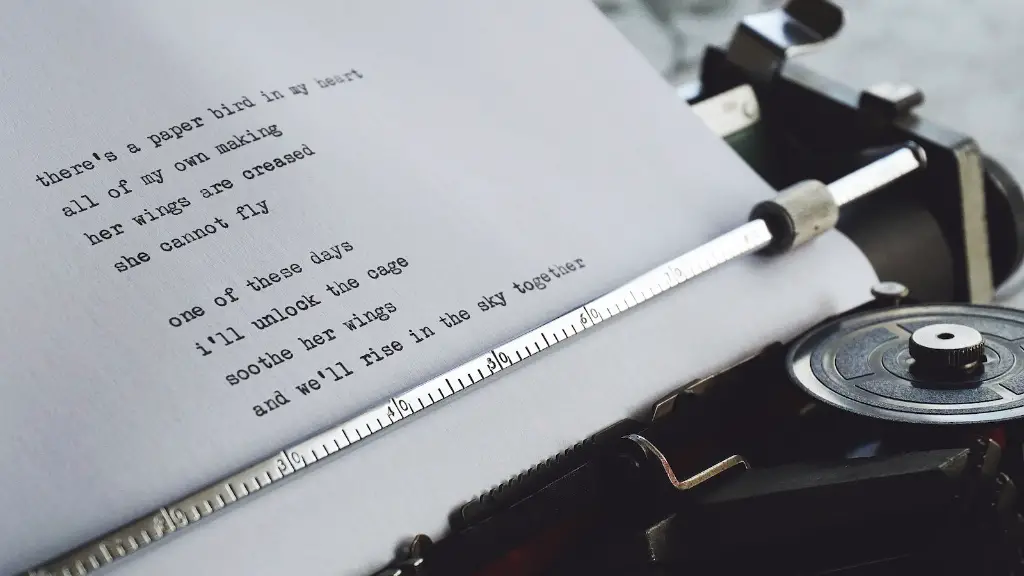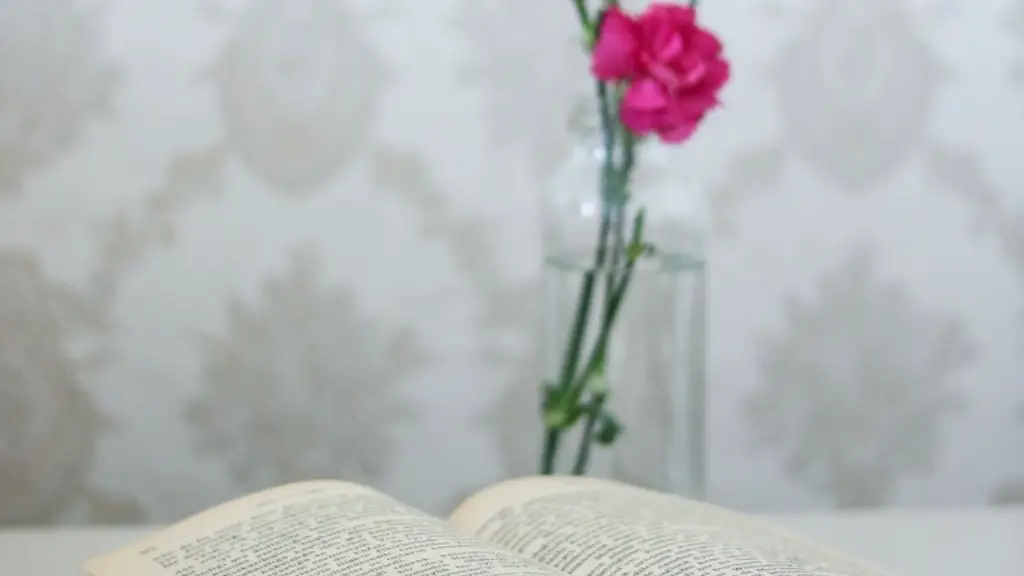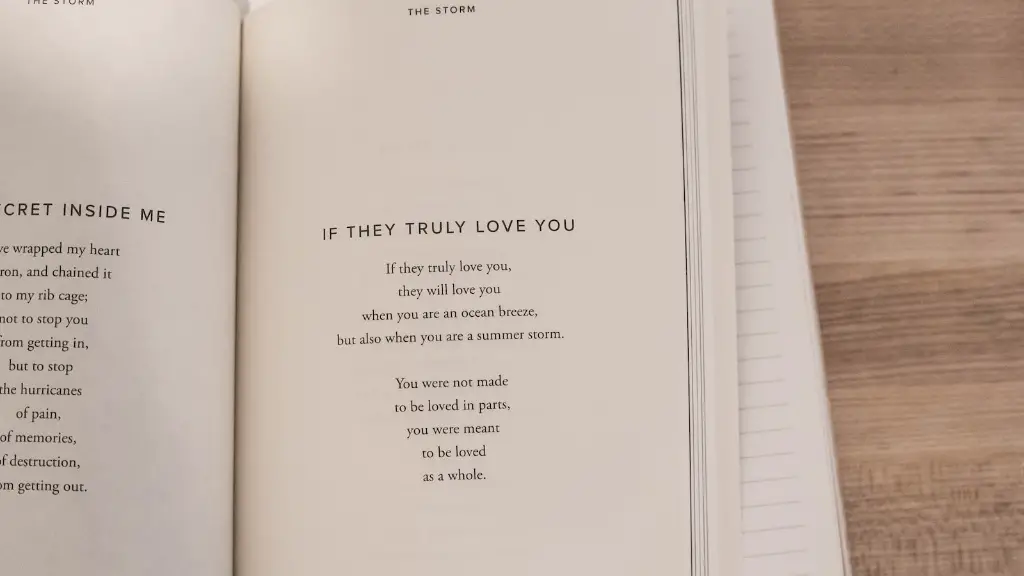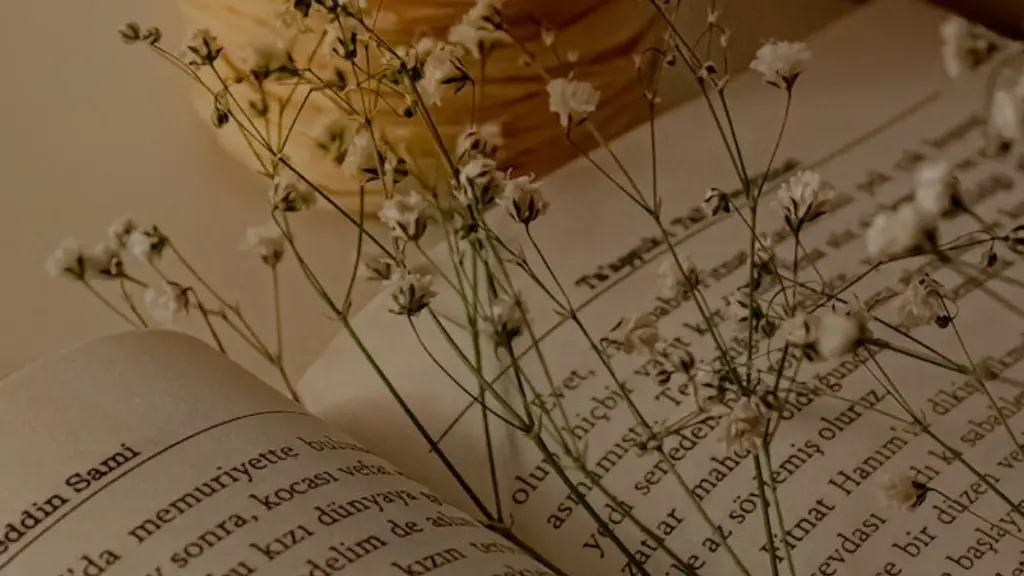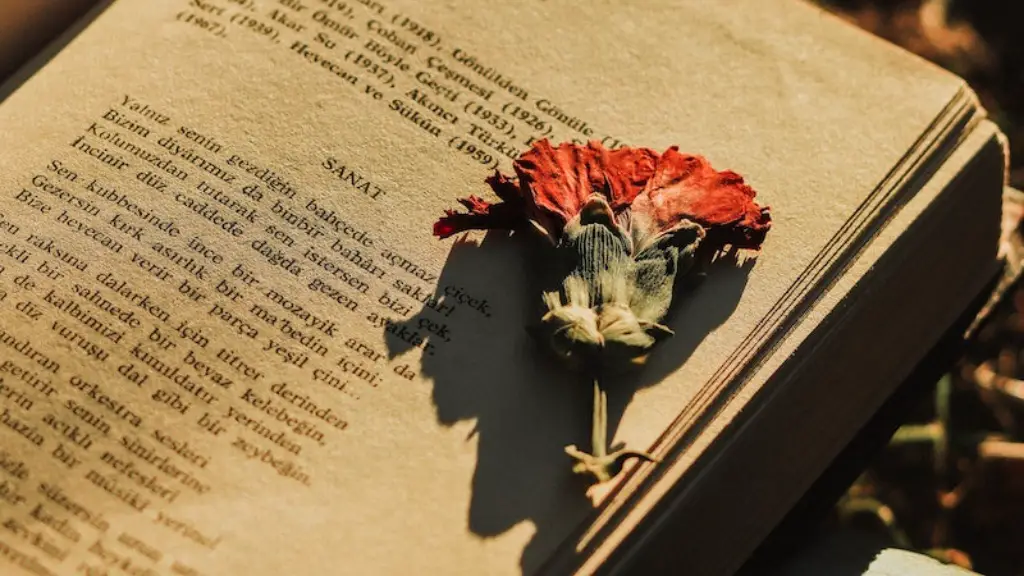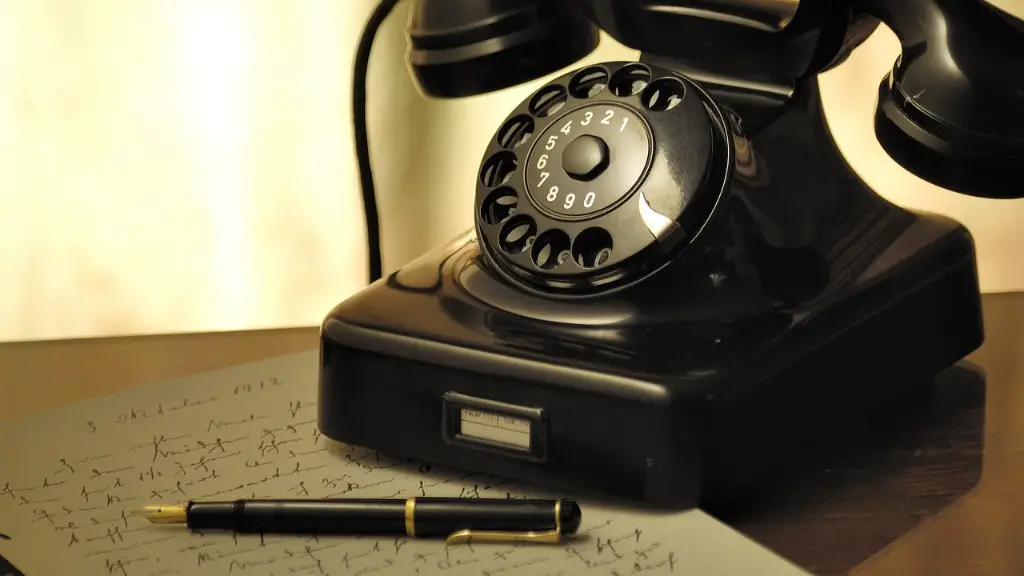Poetry is a form of literary expression that uses words and language to evoke emotions, create imagery and tell stories. Poets use literary devices in their works to give an added dimension, making their words more expressive and poignant. Literary devices are used to make a poem, or other written work, more interesting by instilling a sense of emotion, mystery, creativity, and insight into the writing.
The most common literary devices used in poetry are metaphor, simile, personification, hyperbole, alliteration, puns, rhyme, and meter. Metaphor compares two things that are not necessarily alike and has been used since ancient Greek times. Similes are similar to metaphors, but they are more direct comparisons, usually of two different entity with only one common attribute. Personification allows the poet to imbue life and characteristics into inanimate objects which can make for interesting descriptions.
Hyperbole is an exaggeration used especially to emphasize a point or emphasize an emotion and can be used to evoke laughter or shock. Alliteration is the repetition of consonant sounds at the beginning of words that are close together, a technique given the evocative name of ‘head rhyme’ by Tennyson. Puns, which use a word with multiple meanings to create a humorous comparison, are another popular literary device used by poets. Rhyme and meter are the devices most commonly used in poetry – and often involve the perfect repetition of a sound or the perfect placement of a word.
These and many other literary devices used in poetry can help to make a poem more interesting, dynamic, and evocative. With the proper use of metaphor, simile, and symbolism, an otherwise uninspiring poem can be transformed into an unforgettable work of art. One example of this can be found in William Shakespeare’s classic sonnet, “Shall I Compare Thee to a Summer’s Day”. Here, the author uses a metaphor to compare the beauty of his beloved to that of the summer season.
The use of literary devices, when done properly, can turn a piece of poetry from a simple description of a subject into an emotionally charged and meaningful work of art. Reading works that employ these devices can often evoke a great sense of awe and appreciation for the beauty of words. By taking the time to understand and appreciate the various techniques poets use to express themselves, readers can gain a greater appreciation for the written word.
Descriptive Nature of Poetry
The beauty of written works of poetry is often found in its descriptive nature. Poets use various techniques to bring their works alive, through vivid imagery and engaging metaphors. They use descriptive words and phrases, as well as literary devices such as alliteration and rhyme, to bring their works to life and create a lasting impact on their readers. Descriptive language and vivid imagery can help to create a deeper connection between the story and the reader, making the poem much more powerful.
The use of symbols, personification, and other literary devices can help to convey the deeper meaning and emotions found in the poem. Take, for example, “The Road Not Taken” by Robert Frost. Here, Frost uses a metaphor of a road branching off into two possible paths, as a symbol for the choice one makes in life. Symbols such as this can make a poem more meaningful and give it greater depth.
Poets use language to its fullest potential, to bring the written word to life and evoke powerful emotions in the reader. When used properly, descriptive language and vivid imagery can make a poem truly memorable and impactful.
Rhetorical Devices in Poetry
Rhetorical devices have been used in the art of writing for centuries. These devices, when used properly, can lend a certain power to the poet’s words and can evoke strong emotions in the reader. Poems often employ a variety of rhetorical devices to make their point or to emphasize certain ideas.
The most common rhetorical devices used in poetry include apostrophe, anaphora, repetition, parallelism, and antithesis. An apostrophe is a figure of speech where the speaker directly addresses a deceased or absent person, or an object. Anaphora is the repeating of the same word or phrase, usually at the beginning of a line or stanza. Repetition is the repeating of words, phrases, or lines for emphasis and to create a powerful effect. Parallelism is the use of similar constructions in sentences or phrases, to emphasize a point, create a pattern, or draw a comparison. Antithesis is the juxtaposition of two contrasting ideas in a sentence or phrase, for the purpose of creating a strong rhetorical effect.
Rhetorical devices are an important aspect of poetry and are often used to make an argument or to emphasize a point. By understanding and employing these techniques in their own work, poets can create powerful and meaningful poetry.
Voice in Poetry
Voice is an important element of poetry as it is a reflection of the poet’s unique perspective and experience. Voice is how the poet expresses themselves and how they convey their emotions to the reader. In order to create a unique voice, the poet must find a balance between the structure of the poem and the words they choose.
One way to achieve this balance is to use specific and vivid language. When selecting words, poets should look to evoke a certain emotion while still maintaining the structure and meaning of the poem. It is also important to keep in mind the type of poem being created and the tone that should be carried throughout the work.
Voice in poetry can also be enhanced by the use of literary devices. Techniques such as metaphor and alliteration can add an extra layer of meaning to the words as well as a unique flair to the poem. By using these devices, poets can deepen the impact of their words and create a truly unique voice.
Creating a unique voice is essential to creating meaningful poetry. By understanding and utilizing the various elements of voice and employing rhetorical and literary devices, poets can create powerful and meaningful works of art.
Poetry and Emotions
The power of poetry lies in its ability to evoke emotions in the reader. Whether it is joy, sorrow, or anger, poets use words to stir deep feelings in the reader. The language used and the structure of the poem play an important role in conveying emotion and should be carefully crafted by the poet.
The tone of the poem can be set by selecting language that corresponds to the emotions being expressed. Poets should strive to create a consistent tone that is present throughout the poem. Literary devices such as imagery, personification, and alliteration can also be used to create an emotionally charged atmosphere.
Apart from language, structure can also be used to create an emotional effect. Poets should choose words and lines that build up to a climax and end with a satisfying resolution. This can create an emotional journey for the reader and can make the poem truly powerful.
The ability of a poem to evoke strong feelings and emotions is one of its greatest strengths. By utilizing the various techniques involved in creating emotionally charged works, poets can create powerful works of art that will affect their readers for a long time.
Using Subtext in Poetry
Subtext, or “the hidden meaning”, is an important element in poetry. By including subtle meaning and message within the context of the poem, poets can create works that require more than just a surface-level reading. This use of subtext can add an extra layer of meaning and create a more meaningful connection between the poet and the reader.
The use of symbolism and metaphors are commonly used to suggest a subtext in poetry. Poets should strive to use these devices to hint at an underlying message without explicitly stating it. Here, the author should focus on creating a suggestion, a hint of what the subtext may be, without actually giving it away.
Another technique to use when creating subtext in a poem is situational implication. Here, the poet can use the context of the poem to imply a certain message without actually stating it outright. For example, a poem about a person struggling to rebuild a broken relationship may be implying the difficulty of trying to reconcile after a traumatic event.
Subtext is an important aspect of poetry. By utilizing symbolism, metaphors, and implication, poets can create works that require more than just a cursory reading. By understanding these techniques and utilizing them in their works, poets can create more meaningful works of art.
